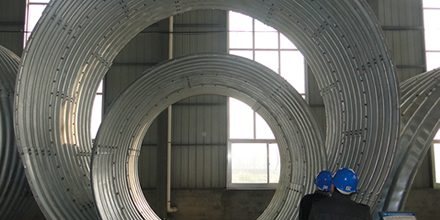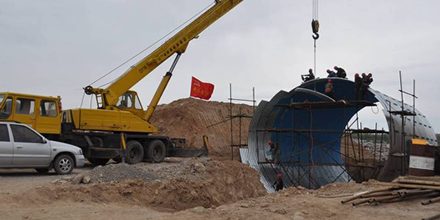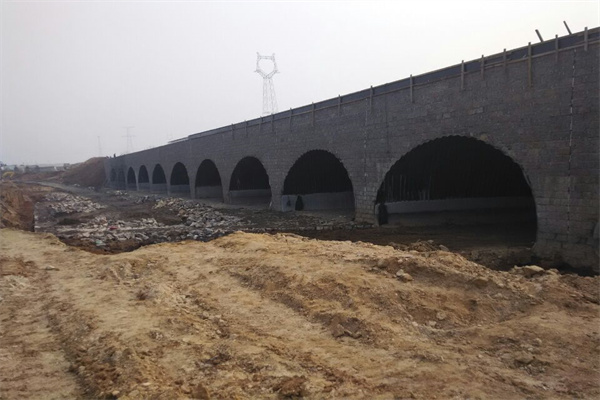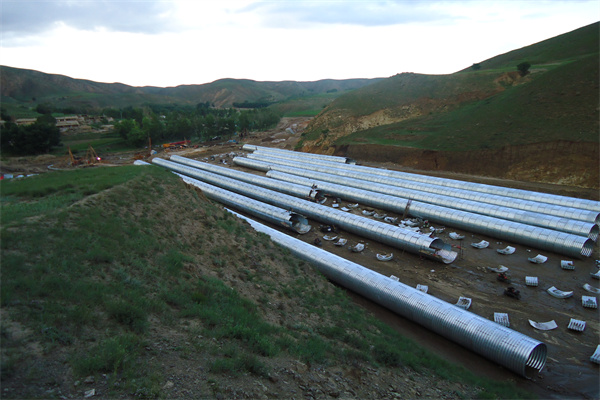Corrugated Pipe Culvert Designing Content
1.The designing content of highway steel corrugated pipe culvert mainly includes follow points:
The calculation of highway culvert water force, and the designing of culvert diameter Design of culvert foundation, burial depth, and skew angle, etc;
Calculation of culvert structure;
Anti corrosion design of culverts;
Requirements for detailed structural design and pipe strength of culverts;
Design of culvert inlet and outlet, and combination design of pipe body and inlet and outlet.
Generally, compared with circular culverts, when do hydraulic calculation of corrugated culverts , we should consider the influence of waveform on the flow properties inside the culvert, Due to the relatively low foundation requirements for steel corrugated pipe culverts, replacement filling can meet general design requirements.
(1) The design of the aperture of highway bridge culverts must ensure the safe passage of various levels of floods, flowing ice, debris flows, drifting objects, etc., and the design also should consider the impact of water blockage and erosion on upstream and downstream, this is to ensure the stability of the embankment near the bridge culvert.
(2) The design of bridge culvert aperture should consider condition of existing or planned bridges, culverts, and hydraulic structures upstream and downstream, as well as their impact on riverbed evolution.
(3) The design of bridge and culvert aperture should also pay attention to the riverbed terrain, and should not excessively reduce the river channel or change the natural state of water flow.
(4) The aperture of small bridges and culverts should be determined based on the design flood discharge, riverbed geology, riverbed and cone slope reinforcement form, and other conditions. When the upstream conditions of small bridges and culverts permit ponding, the flow calculated based on rainstorm runoff can be considered to be reduced, but the reduced flow should not be greater than 1/4 of the total flow.
(5) Culverts should be designed as non pressure type. The net height from the vertex of the non pressure culvert to the standard water level of the designed flood frequency inside the culvert shall comply with the provisions of Table 2-3.
(6) When calculating the vertical soil pressure caused by vehicle loads on the culvert roof, the wheels are distributed at a 30 ° angle downwards from the edge of their contact area. When the pressure diffusion lines of the wheels overlap, the diffusion area is based on the outermost diffusion line.
From the perspective of changes in the life cycle and service level of highways, the service life of culverts has reached 50 years.The design content and applicable conditions can fully meet the needs of general highways, so steel corrugated pipe culverts can be fully suitable for general highways.
For special geotechnical areas, such as permafrost, expansive soil, soft soil, and collapsible loess, reinforced concrete circular culverts or slab culverts generally suffer varying degrees of damage during use. The more serious disease is the uneven settlement of the foundation or foundation, which leads to the destruction of the culvert. The service life of reinforced concrete circular pipe culverts or slab culverts in these areas is sometimes less than 20 years. The application of steel corrugated pipe culverts can completely solve the problem of culvert damage caused by foundation deformation, and at the same time reduce stress concentration on the road surface due to foundation settlement. Therefore, steel corrugated pipe culverts have more advantages in the above-mentioned areas. The culvert pipe is a flexible structure, which is conducive to improving the "misalignment phenomenon" at the junction of soft soil foundation structures and embankments, and also the corrugated pipe culvert used can improve the comfort and safety of driving.
2) Applicable conditions
From analysis of the usage, stress characteristics, and anti-corrosion of steel corrugated pipe culverts, the application of steel corrugated pipe culverts must meet the following conditions:
(1) The corresponding waveform must have sufficient wall thickness to ensure that the maximum stress of the steel corrugated pipe structure under load is lower than the allowable stress (or yield stress) of the steel structure.
(2) The anti-corrosion treatment of steel corrugated pipes must not be lower than standard requirements. to ensure that steel corrugated pipe culverts have sufficient corrosion resistance within a certain period of time; The thickness of the steel plate wall should be appropriately considered with anti-corrosion allowance.
(3) The steel corrugated pipe should be able to withstand deformation caused by standard loads, without causing nonlinear damage, and without affecting the function of the upper structural layer.
With the widespread application of steel corrugated pipe culverts, research on waveform and wall thickness optimization will gradually deepen. The optimized waveform can use relatively thin structural steel to adapt to corresponding fill and vehicle loads.When the deformation requirements for highways are high, and the height of the culvert top fill is small, the corresponding waveform and wall thickness should be selected reasonably according to the culvert aperture to control the deformation of the culvert pipe under load. and this prevent excessive deformation of the bottom of the road surface; The height of the culvert roof fill and other design parameters can also be controlled based on the deformation condition.
3. Selection principles
The selection of highway steel corrugated pipe culverts must follow the principles of applicability, safety, and economy, and the good mechanical performance advantages of steel corrugated pipe structures on the basis of meeting functional requirements should aslo be known. The design of steel corrugated pipe culverts for highways should adhere to the principles of adapting to local conditions, leveraging advantages, and not using them for specific purposes. In addition to fully considering the basic characteristics of the engineering project, including highway grade, importance, topography, adverse geological conditions, roadbed construction, etc., the following factors should also be considered in the design: construction conditions and convenience; Maintenance conditions; Secondary anti-corrosion. Steel corrugated pipe culverts should be given priority in the following areas.
(1) Culverts with poor soil foundation, including permafrost, expansive soil, soft soil, collapsible loess, etc;
(2) Lack of human resources or high-risk, high-altitude hypoxic areas and other engineering projects;
(3) Areas with limited sand and gravel resources,and areas with long transportation distances for cement, steel, and other materials;
(4) Emergency rescue and disaster relief projects aimed at accelerating construction progress and achieving rapid traffic opening. The following situations should be used with caution.
 Products
Products Application
Application



